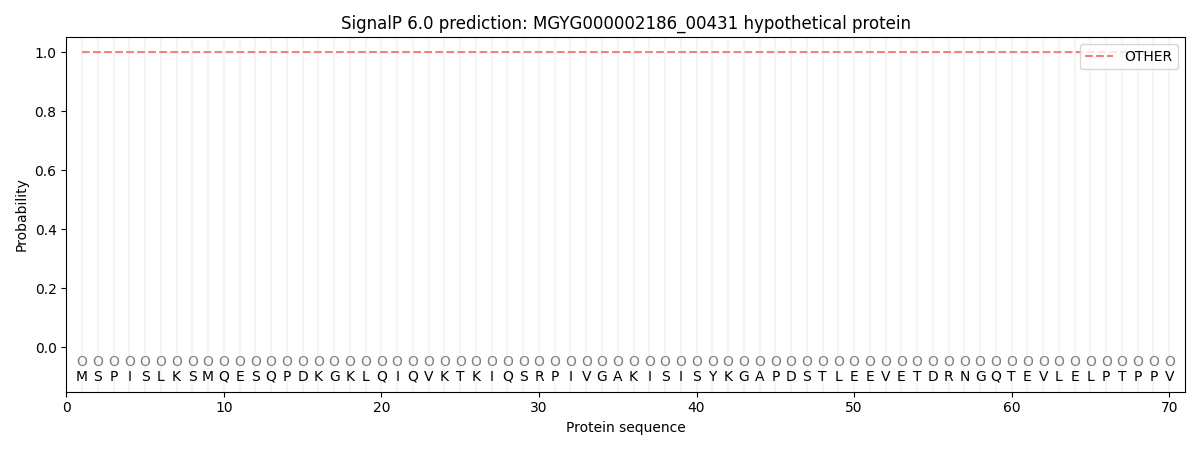You are browsing environment: HUMAN GUT
CAZyme Information: MGYG000002186_00431
You are here: Home > Sequence: MGYG000002186_00431
Basic Information |
Genomic context |
Full Sequence |
Enzyme annotations |
CAZy signature domains |
CDD domains |
CAZyme hits |
PDB hits |
Swiss-Prot hits |
SignalP and Lipop annotations |
TMHMM annotations
Basic Information help
| Species | Ruminococcus_A sp000432335 | |||||||||||
|---|---|---|---|---|---|---|---|---|---|---|---|---|
| Lineage | Bacteria; Firmicutes_A; Clostridia; Lachnospirales; Lachnospiraceae; Ruminococcus_A; Ruminococcus_A sp000432335 | |||||||||||
| CAZyme ID | MGYG000002186_00431 | |||||||||||
| CAZy Family | GH0 | |||||||||||
| CAZyme Description | hypothetical protein | |||||||||||
| CAZyme Property |
|
|||||||||||
| Genome Property |
|
|||||||||||
| Gene Location | Start: 97989; End: 99251 Strand: + | |||||||||||
CDD Domains download full data without filtering help
| Cdd ID | Domain | E-Value | qStart | qEnd | sStart | sEnd | Domain Description |
|---|---|---|---|---|---|---|---|
| pfam01471 | PG_binding_1 | 7.08e-14 | 345 | 406 | 1 | 57 | Putative peptidoglycan binding domain. This domain is composed of three alpha helices. This domain is found at the N or C-terminus of a variety of enzymes involved in bacterial cell wall degradation. This domain may have a general peptidoglycan binding function. This family is found N-terminal to the catalytic domain of matrixins. The domain is found to bind peptidoglycan experimentally. |
| COG3409 | PGRP | 5.13e-09 | 342 | 408 | 41 | 104 | Peptidoglycan-binding (PGRP) domain of peptidoglycan hydrolases [Cell wall/membrane/envelope biogenesis]. |
| COG3409 | PGRP | 1.48e-07 | 336 | 406 | 117 | 183 | Peptidoglycan-binding (PGRP) domain of peptidoglycan hydrolases [Cell wall/membrane/envelope biogenesis]. |
| pfam13620 | CarboxypepD_reg | 1.40e-06 | 30 | 116 | 12 | 81 | Carboxypeptidase regulatory-like domain. |
| cd01450 | vWFA_subfamily_ECM | 0.009 | 175 | 275 | 10 | 105 | Von Willebrand factor type A (vWA) domain was originally found in the blood coagulation protein von Willebrand factor (vWF). Typically, the vWA domain is made up of approximately 200 amino acid residues folded into a classic a/b para-rossmann type of fold. The vWA domain, since its discovery, has drawn great interest because of its widespread occurrence and its involvement in a wide variety of important cellular functions. These include basal membrane formation, cell migration, cell differentiation, adhesion, haemostasis, signaling, chromosomal stability, malignant transformation and in immune defenses In integrins these domains form heterodimers while in vWF it forms multimers. There are different interaction surfaces of this domain as seen by the various molecules it complexes with. Ligand binding in most cases is mediated by the presence of a metal ion dependent adhesion site termed as the MIDAS motif that is a characteristic feature of most, if not all A domains |
CAZyme Hits help
| Hit ID | E-Value | Query Start | Query End | Hit Start | Hit End |
|---|---|---|---|---|---|
| AWY98201.1 | 2.63e-224 | 6 | 419 | 6 | 420 |
| QJU14725.1 | 6.16e-223 | 6 | 419 | 6 | 420 |
| QQQ92685.1 | 6.16e-223 | 6 | 419 | 6 | 420 |
| ASU27931.1 | 6.16e-223 | 6 | 419 | 6 | 420 |
| ASM69598.1 | 6.16e-223 | 1 | 419 | 1 | 420 |
Swiss-Prot Hits help
SignalP and Lipop Annotations help
This protein is predicted as OTHER

| Other | SP_Sec_SPI | LIPO_Sec_SPII | TAT_Tat_SPI | TATLIP_Sec_SPII | PILIN_Sec_SPIII |
|---|---|---|---|---|---|
| 1.000058 | 0.000000 | 0.000000 | 0.000000 | 0.000000 | 0.000000 |
